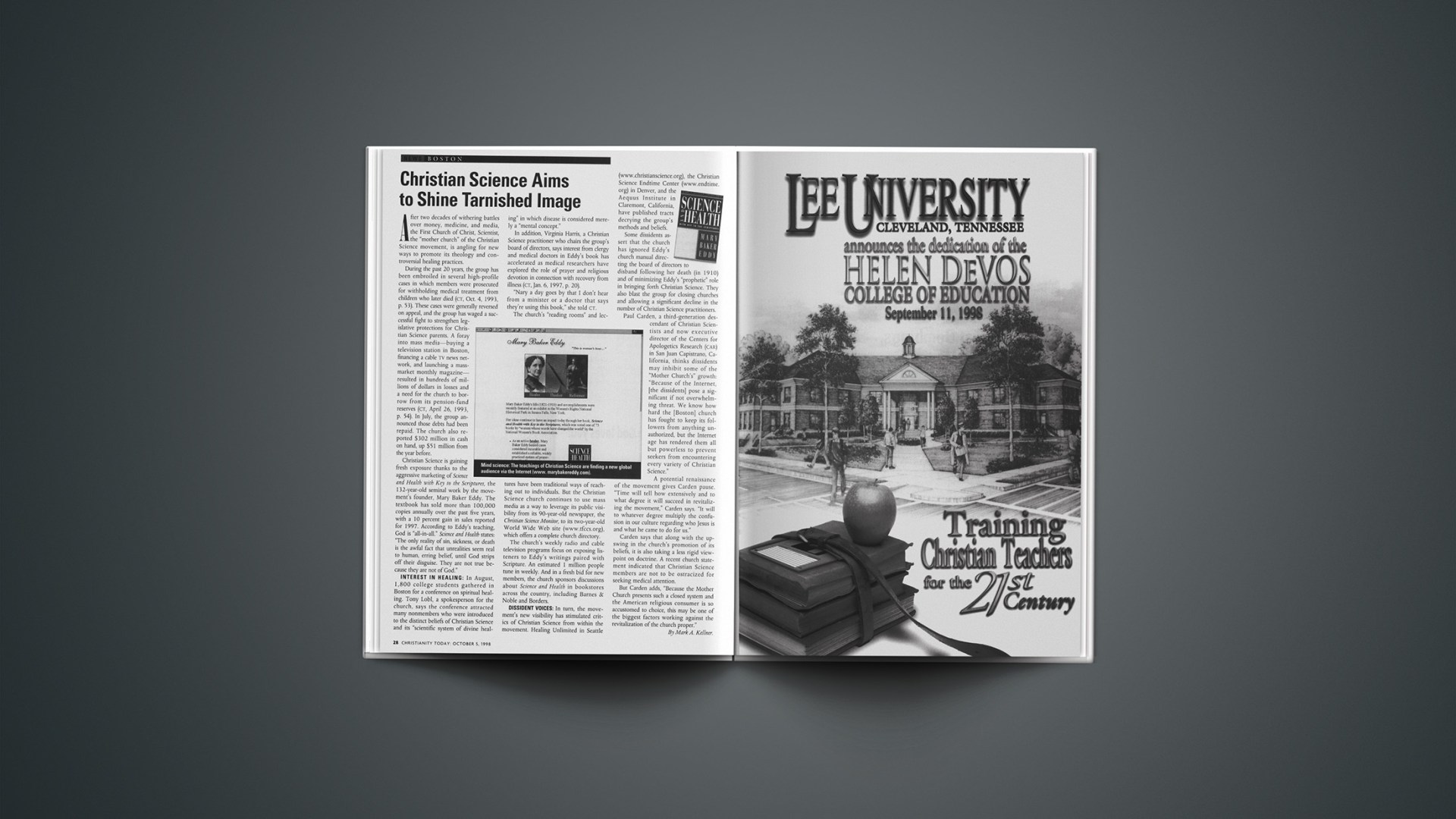After two decades of withering battles over money, medicine, and media, the First Church of Christ, Scientist, the “mother church” of the Christian Science movement, is angling for new ways to promote its theology and controversial healing practices.
During the past 20 years, the group has been embroiled in several high-profile cases in which members were prosecuted for withholding medical treatment from children who later died (CT, Oct. 4, 1993, p. 53). These cases were generally reversed on appeal, and the group has waged a successful fight to strengthen legislative protections for Christian Science parents. A foray into mass media—buying a television station in Boston, financing a cable tv news network, and launching a mass-market monthly magazine—resulted in hundreds of millions of dollars in losses and a need for the church to borrow from its pension-fund reserves (CT, April 26, 1993, p. 54). In July, the group announced those debts had been repaid. The church also reported $302 million in cash on hand, up $51 million from the year before.
Christian Science is gaining fresh exposure thanks to the aggressive marketing of Science and Health with Key to the Scriptures, the 132-year-old seminal work by the movement’s founder, Mary Baker Eddy. The textbook has sold more than 100,000 copies annually over the past five years, with a 10 percent gain in sales reported for 1997. According to Eddy’s teaching, God is “all-in-all.” Science and Health states: “The only reality of sin, sickness, or death is the awful fact that unrealities seem real to human, erring belief, until God strips off their disguise. They are not true because they are not of God.”
INTEREST IN HEALING: In August, 1,800 college students gathered in Boston for a conference on spiritual healing. Tony Lobl, a spokesperson for the church, says the conference attracted many nonmembers who were introduced to the distinct beliefs of Christian Science and its “scientific system of divine healing” in which disease is considered merely a “mental concept.”
In addition, Virginia Harris, a Christian Science practitioner who chairs the group’s board of directors, says interest from clergy and medical doctors in Eddy’s book has accelerated as medical researchers have explored the role of prayer and religious devotion in connection with recovery from illness (CT, Jan. 6, 1997, p. 20).
“Nary a day goes by that I don’t hear from a minister or a doctor that says they’re using this book,” she told CT.
The church’s “reading rooms” and lectures have been traditional ways of reaching out to individuals. But the Christian Science church continues to use mass media as a way to leverage its public visibility from its 90-year-old newspaper, the Christian Science Monitor, to its two-year-old World Wide Web site (www.tfccs.org), which offers a complete church directory.
The church’s weekly radio and cable television programs focus on exposing listeners to Eddy’s writings paired with Scripture. An estimated 1 million people tune in weekly. And in a fresh bid for new members, the church sponsors discussions about Science and Health in bookstores across the country, including Barnes & Noble and Borders.
DISSIDENT VOICES: In turn, the movement’s new visibility has stimulated critics of Christian Science from within the movement. Healing Unlimited in Seattle (www.christianscience.org), the Christian Science Endtime Center (www.endtime.org) in Denver, and the Aequus Institute in Claremont, California, have published tracts decrying the group’s methods and beliefs.
Some dissidents assert that the church has ignored Eddy’s church manual directing the board of directors to disband following her death (in 1910) and of minimizing Eddy’s “prophetic” role in bringing forth Christian Science. They also blast the group for closing churches and allowing a significant decline in the number of Christian Science practitioners.
Paul Carden, a third-generation descendant of Christian Scientists and now executive director of the Centers for Apologetics Research (car) in San Juan Capistrano, California, thinks dissidents may inhibit some of the “Mother Church’s” growth: “Because of the Internet, [the dissidents] pose a significant if not overwhelming threat. We know how hard the [Boston] church has fought to keep its followers from anything unauthorized, but the Internet age has rendered them all but powerless to prevent seekers from encountering every variety of Christian Science.”
A potential renaissance of the movement gives Carden pause. “Time will tell how extensively and to what degree it will succeed in revitalizing the movement,” Carden says. “It will to whatever degree multiply the confusion in our culture regarding who Jesus is and what he came to do for us.”
Carden says that along with the upswing in the church’s promotion of its beliefs, it is also taking a less rigid viewpoint on doctrine. A recent church statement indicated that Christian Science members are not to be ostracized for seeking medical attention.
But Carden adds, “Because the Mother Church presents such a closed system and the American religious consumer is so accustomed to choice, this may be one of the biggest factors working against the revitalization of the church proper.”
Copyright © 1998 Christianity Today. Click for reprint information.










